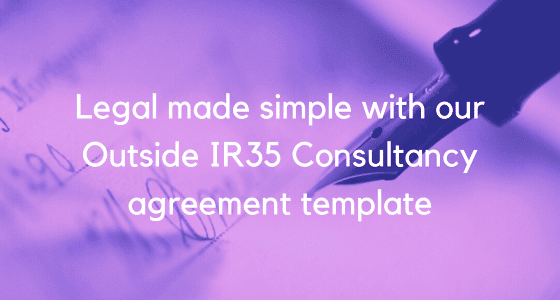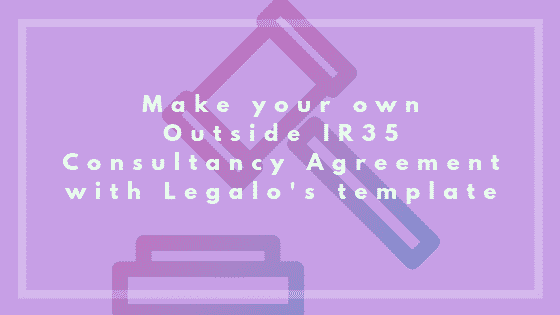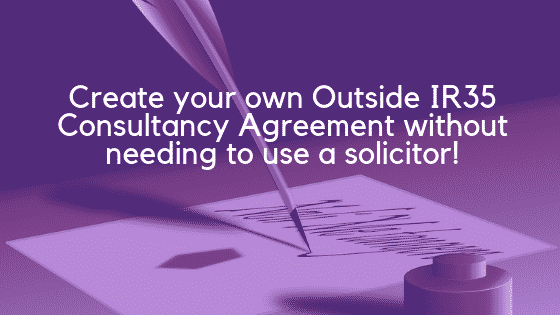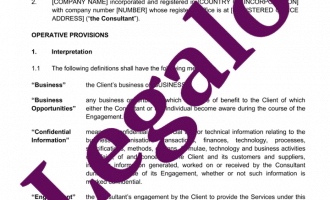Outside IR35 Consultancy Agreement – For A Company
Our Outside IR35 Consultancy Agreement template:
- Helps the company to retain its self-employed contractor status
- Assists you with the private sector changes that took place in April 2021
- Goes hand-in hand with what you do in practice
- Drafted by an experienced UK Solicitor in association with an external consultant

How Does It Work?
-
1. Download
-
2. Edit
-
3. Print
-
4. Sign
While we already have a simple template for a consultancy agreement for a company, it is drafted mainly in favour of the client, not the consultant. With the changes to the IR35 rules that came in from April 2021, to tackle what HM Revenue & Customs call “disguised remuneration” in the private sector, the consultant may want to present the client with their own consultancy agreement. They may want one that is more in their favour and deals with IR35 issues in a more focussed way. This will better protect the consultant and his or her tax status as a self-employed person. Hence the need for our Outside IR35 Consultancy Agreement template.
If the consultant is an individual and not a company then use our Outside IR35 Consultancy Agreement for an Individual.
This template will suit the consultant more as it is both:
- more in favour of the consultant; and
- addresses the key issues under IR35 that can be a problem for the consultant’s tax status.
Staying “Outside IR35” with our Consultancy Agreement
Being “outside IR35” means that you are genuinely a self-employed business. If you’re claiming self-employed status that is not thought to be genuine, we call this being “inside IR35”. The law catches your business and subjects it to tax as if the individual being supplied by it were an employee. However, the law says the individual supplied by the business does not automatically receive any of the employment rights or benefits!
Private sector self-employed contractors are responsible for deciding their tax status at present. To do so, you should:
- review your contract for IR35 compliance; and
- conduct an assessment of your working practices.
This is because the key to avoiding IR35 tax problems is to ensure that:
- the contract is consistent throughout in demonstrating the relationship is genuinely one of self-employment; and
- in practice the consultant operates in accordance with this contract. Then the status remains consistent as being one of self-employed status.
If the contract is great but in practice that is not how you really operate, then you will have problems. Vice versa, if the way you operate looks like self-employment but the contract is poorly worded and appears to be inconsistent, then again you may end up with problems. Such problems could be significant, as HM Revenue & Customs can levy penalty charges and interest for failing to tax the individual as an employee, if they decide that is what you and your client should have been doing all along.
The changes to IR35 in April 2021 for Consultancy Agreements
The law on IR35 came into effect way back in April 2000, aimed at catching “disguised remuneration”. Then it was focussed on an individual using a limited company (a “personal services company”) as the vehicle for his or her business, where it might look like the person was an employee if the company did not exist.
HM Revenue & Customs have had on-going problems with getting more self-employed relationships classed as employment situations and raising the anticipated extra £300 million a year through this legislation. (To see just how far short the extra tax revenue raised was, read this short article in Wikipedia: https://en.wikipedia.org/wiki/IR35#Revenue_raised.)
Their latest changes to tax law for the self-employed are in two parts under the Finance Act 2017:
- In April 2017 the law changed for any consultants engaged by public bodies, e.g. the BBC, the NHS or central and local government departments. This now means the public sector client has to make a determination on the consultant’s tax status.
- In April 2021 the law changed for all others, i.e. consultants engaged by private sector bodies, e.g. businesses, charities and other non-governmental organisations. At this point, the private sector clients will all need to make determinations on the status of their contractors.
Technically, the law that determines whether you are an employee or self-employed for tax purposes has not changed recently. So anyone genuinely operating outside IR35 should be able to continue doing so.
Fix it with an Outside IR35 Consultancy Agreement
However, the bigger problem is that HM Revenue & Customs are going to put the onus on the client to make a determination or face the liability for the payment of the PAYE tax, interest and penalties that HMRC would levy if the person were an employee. Some clients may decide to be ultra-cautious and make all their self-employed contractors “employees”. This could happen at the drop of the hat now that April 2021 has arrived. To do so would be unfair.
Our new template seeks to redress the balance and offer solutions to this possible unilateral action by a client, such as:
- clauses that give the individual supplied all the employment rights if the client opts to tax you as an employee. (Without such clauses, the individual would get no rights but the business would suffer all the tax.);
- require either a minimum notice period before the client starts to tax as an employee, or a payment if they fail to give the right notice period; and
- allow the contractor and/or the individual supplied an option to terminate the contract and decide not to become an employee.
Why act on IR 35 now with your Consultancy Agreements?
If you are a consultant who is in the habit of taking engagements with private sector clients, then you need to review your usual contract terms and see if they are sufficiently tight. Does your contract offer you good protection in the event someone were to query the business’s tax and/or self-employment status? If you run fairly long-term contracts, then you will want to get one in place now that will put you in a good position from April 2021.
No contract can guarantee you will never be caught out and the key is twofold:
- have a good written contract; and
- in practice, operate consistently with the terms of the contract and the status as self-employed.
Our Outside IR35 Consultancy Agreement template can be a great help to you with the first part of this. The second part is up to you.
Why use Legalo’s Outside IR35 Consultancy Agreement template?
An experienced UK Solicitor, who has been working on IR35 issues since it first came into force in 2000, has drafted our template. He has recently reviewed and redrafted it, to address the changes from April 2021 better.
This review has been with the added assistance of someone working in the consulting industry, who understands the issues and the needs and experiences of individual consultants. You can therefore be sure that this Outside IR35 Consultancy Agreement will help you to protect your interests and your tax status as a contractor.
Feedback from you on our Outside IR35 Consultancy Agreement
We would like to receive your feedback and comments on this template when you use it in practice. Your feedback will help us further refine the template and improve it for the benefit of you and other contractors. Whenever we update a template, anyone who has bought it will be notified and have access to the updated version free of charge, so you will also benefit from this.
If you are happy to assist in this way, do get in touch.

Guide to our Outside IR35 Consultancy Agreement for a Company
What follows is an excerpt from the guide to the template that you will receive when you buy it.
This is a guide to our “Outside IR35” Consultancy Agreement template. It is for use by a consultant that is to be taken on by a client where the consultant is:
- a partnership or a limited company (or one or more shareholders operating via a company, including a “personal services company”); and
- to be an independent contractor and the individual supplied by the partnership or company is genuinely not an employee of the business hiring the consultant.
This agreement incorporates various options, so it is appropriate:
- whatever the nature of the services being supplied; and
- whatever the length of the contract: short-term, long-term, an indefinite term or a fixed term.
If the consultant is an individual and is contracting in his own right, then you need our other outside IR35 consultancy agreement template – called “Outside IR35 consultancy agreement for an individual”.
Self-employed status or employee?
The question of whether a worker is an employee or an independent contractor is not entirely up to the parties – the Employment Tribunal and HM Revenue and Customs both might have their own views on this, so what you state in your contract is not conclusive. It is important that the Agreement is a true reflection of the reality of your working relationship. In relation to personal services companies, the Revenue’s rule called IR35 has been in place for a good number of years and can be used by the Revenue to bypass the use of a company by an individual who they feel is, but for the use of a company, an employee of the hiring company, thus allowing them to charge more tax and national insurance, for which the hiring company can find itself responsible. (If you need more information on IR35, please see: https://en.wikipedia.org/wiki/IR35.)
However, knowing what the Revenue considers in this regard can help you to set up your arrangements in best practise for a genuinely independent contractor. This agreement covers the 3 main considerations:
(a) Mutuality of Obligation,
(b) Supervision, and
(c) Direct & Control & Substitution.
Used correctly, you can ensure the provision of a complete & robust self-employed consultancy service.
The agreement presumes a single individual will be provided by the consultant to carry out the vast majority of the work (e.g. a personal services company situation), rather than a team or a series of individuals. This agreement can be adapted to cater for the latter situation if need be (and there are then significantly fewer risks of IR35 applying).
Reflect reality in your Outside IR35 Consultancy Agreement
This consultancy agreement should reflect the true working relationship between parties and is designed to be used where the contractor is a self-employed contractor and the individual is not an employee of the client. This agreement is not suitable for employees taking temping contracts or other arrangements where the consultant is not an employee of the end client. Legalo cannot guarantee that the arrangement is accepted as genuine by HM Revenue & Customs. Much depends on how the parties operate the contract in reality. This template contract is designed to support the genuine situation, but it is down to the consultant and individual to ensure that they operate under it in a manner consistent with this tax status at all times and, if questioned by HMRC on the situation, that the answers given are also genuine and consistent.
The client’s decision
Due to the April 2021 change in the law for private sector contractors, the client will have to make a decision on the tax status for the contractors they engage. Some clients may make a decision to treat all the individuals supplied by their contractors as employees for the purposes of the legislation. The client would then withhold tax on a PAYE basis from the contractor’s payments. While the consultant is not a decision maker in this process, it will impact their Business. Our template helps both parties to address any problems and empowers them to agree a mechanism for any potential changes. See the notes below on Schedule 2 of the template for details.
We have designed this template to cover a full range of eventualities and reduce the ambiguity surrounding an ‘inside-IR35’ determination. Please note that not all clauses in this template will be immediately accepted by all clients, so be prepared for open discussions around some of the points in play and to make amendments as negotiated.
Guide to Numbered Clauses in this Outside IR35 Consultancy Agreement for a Company
Below we have set out a much-abbreviated version of our guide to each clause. You get the much fuller detailed version when you purchase the template.
1. Interpretation
This clause defines the main terms used in the agreement.
2. Term of engagement
This states that the client takes on the consultant so the latter can provide the services to the client. The longer the term and if the individual supplied by the consultant does not work for other clients during that period, then the greater the risk that the individual will become an employee of the client. The purpose of clause 2.3 (about ”mutuality of obligation” or “MOO” for short) is an important pointer towards a genuine self-employment status for the contractor, so do not delete it.
3. Duties of the consultant
This clause deals with how the consultant is to provide the services and what responsibilities it has to act properly towards the client. Clause 3.2 tackles “supervision, direction and control” (or “SD&C” for short). Clause 3.4 gives the consultant a right to send a substitute.
4. Charges
In clause 4.1 set out the rate of pay agreed with the consultant.
5. Expenses
If the consultant is due to receive reimbursement of proper expenses, this clause covers it.
6. Relationship
As noted above, the “independent contractor” status that you state applies in clause 6.1 is not conclusive of the actual status of the individual supplied by the consultant.
7. Other interests
Clause 7 confirms the consultant can have other work, but it aims at avoiding the consultant’s working for a competitor (at least) during the engagement.
8. Intellectual property
This clause puts in place protection for the client’s existing intellectual property rights and any more such rights created by the consultant during the engagement.
9. Insurance
The consultant needs to holds his own insurance, as per the definition of “the Insurance”.
10. Termination
Clause 10.1 provides that either party can terminate the engagement on giving suitable written notice to the other. We intend this might be useful for lengthy or open-ended engagements. However, this might not be appropriate to a short engagement, so the template includes an alternative option.
11. Consequences of termination
When a party terminates the agreement (for whatever reason), the consultant needs to hand over to the client all assets belonging to the client and all material relating to the engagement (including copies from its computers), and then delete any copies still remaining on its computers.
12. Confidential information
This clause seeks to protect the client’s confidential information.
13. Data protection
This clause authorises the client to handle personal data on the consultant as needed for the engagement.
14. IR35 and grossing-up for tax
If the client determines that the Consultant is inside-IR35 and to starts taxing them as an employee, it will have a material impact on the cashflow of the business and may affect their profits. This clause addresses this.
15. Interest
Any late payments will incur interest.
16. Compliance with laws and policies
This clause requires the parties to ensure their supply chains are ethical (reference to the Modern Slavery Act 2015, etc).
(There are some other standard clauses we include in the template that we explain in the guide. They do not merit mention here.)
Schedule 1
You should insert full and clear details of the specific work the consultant is to do for the client here.
Schedule 2
This schedule tackles the situation where the client determines that the consultant is ‘inside-IR35 & starts to tax the consultant as if the individual were subject to PAYE tax deductions as an employee.
(The guide also explains how to sign the agreement.)



